 Following on from my previous blog post which talked about the positive effect of online reviews on our purchase decision-making process, today I’m going to have a look at the importance of product descriptions.
Following on from my previous blog post which talked about the positive effect of online reviews on our purchase decision-making process, today I’m going to have a look at the importance of product descriptions.
Believe it or not, but the words you use (or you don’t use) to describe your products can make or break a sale. They are certainly not the only factor that positively influences conversions but they play a key part in consumers’ online shopping experience.
A good product description can:
- Create an emotional connection
- Make your visitors take an action
- Improve conversions and increase revenue
Product descriptions are important for both, consumers and Search Engines
Unfortunately, there are still a lot of e-commerce websites (big and small) that haven’t embraced the power of product descriptions; they either have one-sentence descriptions or even ‘better’… no descriptions at all.
If you have no words describing the product how on earth are you going to convince your potential customers to buy it from your website? Don’t forget about the search engines; they are not human and they can’t read images. They are also pretty demanding and if your website employs zero-words in descriptions Google won’t like you and may award you with low rankings.
Think of product descriptions as sales assistants in the offline shop. They are there to guide you, help you pick the best product and answer your questions. A good sales assistant tells you everything you need to know about the product using the right set of words to convince you to make a purchase. This is exactly the purpose of a good product description in the online world. Make sure you apply this principle to your website: the description on your product page is a virtual sales assistant whose job is the same as a sales assistant but using the written word.
Your role is to write compelling copy that will entice visitors to buy your products. Simples!
If you think that your product is so simple (or so boring) that you can’t write an engaging product description then take a look at the Zappos example below.
Would you ever imagine that a simple yellow towel can be described in a compelling way? Well, Zappos will change your mind:
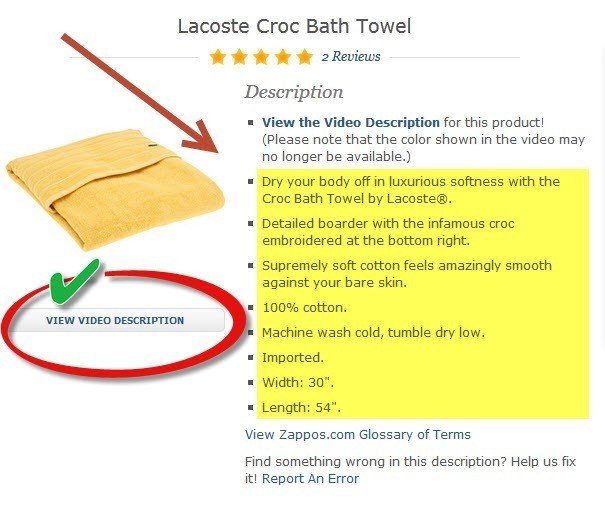
What more? They even created a 20-seconds long video showing and explaining everything you should know about the towel:
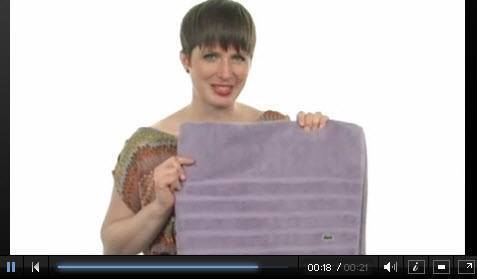
So, if you think that your product is boring and you will never ever be able to write an engaging description for it, think again.
To make you believe in the power of product descriptions I have picked another example; a bath tap which is quite expensive (over £1,000) so I as a customer would like to find out more (almost everything) about this tap before paying for it.
I have looked at the product descriptions for this bath tap on three different website and here are the results:
Example #1 – Bad – No description at all, only the full name of the product
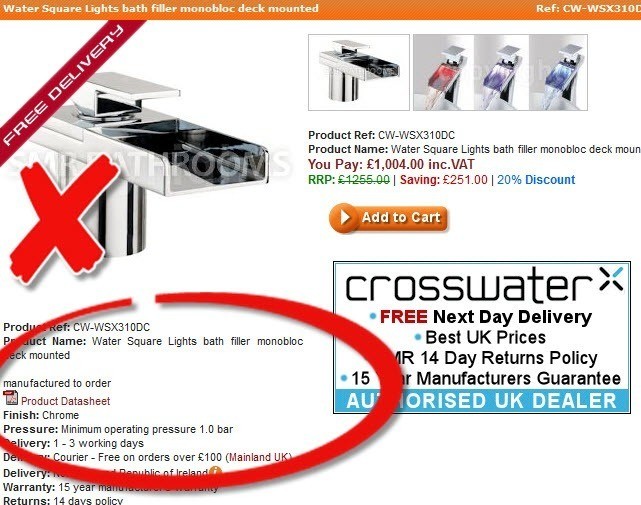
Example #2 – Not bad but to be honest it could be better. They are also missing elements such as top features/technical specifications.
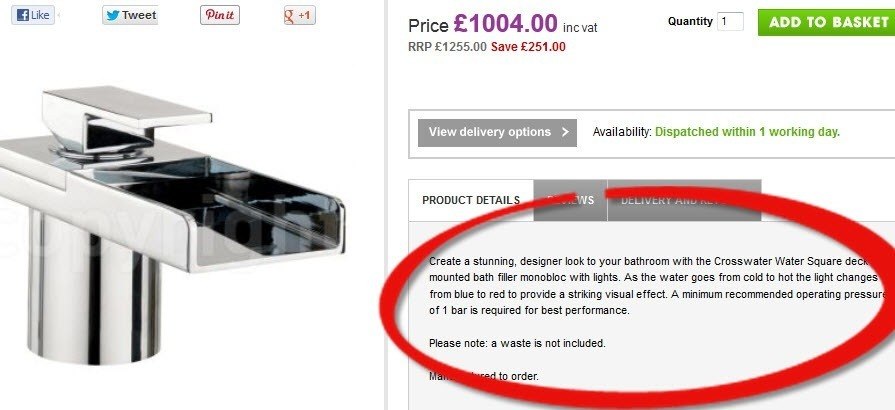
Example #3 – The winner – Very good – compelling and unique
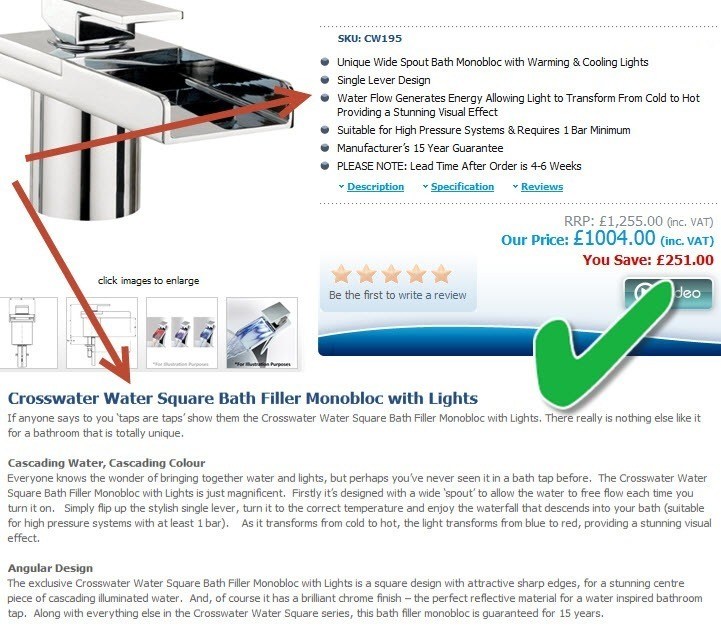
Customised product descriptions can have a positive impact on your sales, add value to your website and most importantly help customers in their decision making process. If you don’t know how to write them here are 5 steps you should follow when creating product descriptions for your e-commerce website:
1. Use the tone and language of your target market
First of all you need to understand the person who will read your descriptions; thus, the knowledge of your target audience is the key for writing effective product descriptions. Having a well-defined marketing persona will help you write more personalised descriptions that will appeal to your customers.
If you don’t have your marketing personas in place try thinking of the words your typical customer would use to describe the product.
Take a look at Roxy which tailors the product descriptions to its target market of young people and teenagers by using their language.
The phrases and words common for young people such as ‘stylish’ and ‘can‘t-live-without’ are indicative of the Roxy brand and you can find them all over their website as well as in the product descriptions.
Roxy also provides useful hints and tips in its product descriptions (e.g. ‘wear it at festivals’, ‘looks great layered under T-shirts’, etc.). Hints and tips within the description help generating the feel of excitement about the item before it reaches the customer.
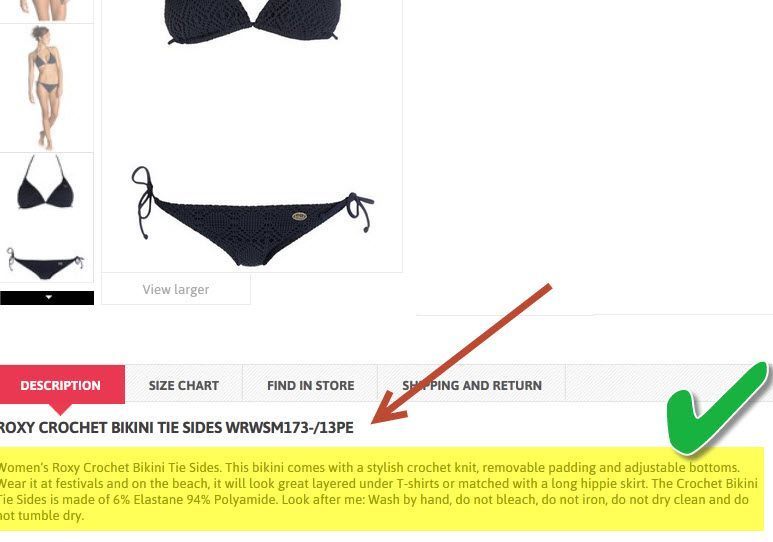
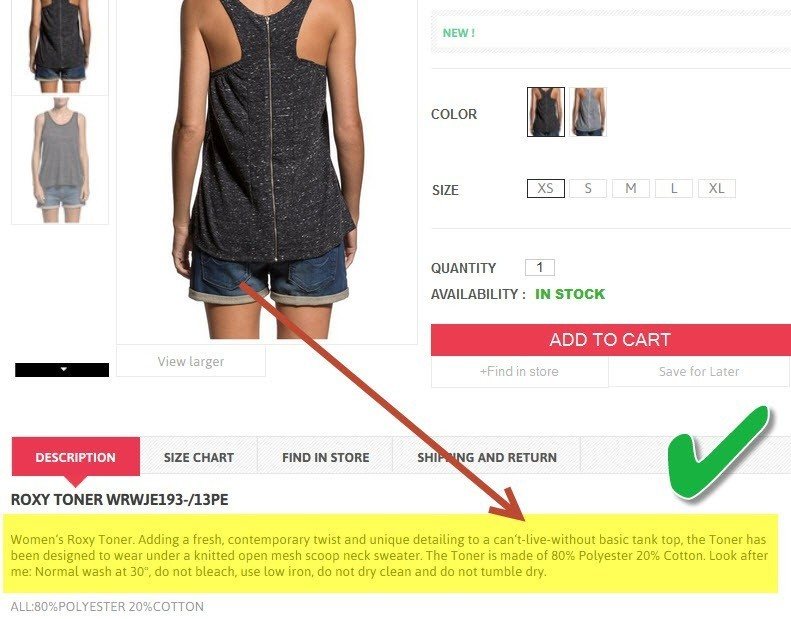
2. Stop duplicating manufacturer descriptions and using industry jargon
If you are one of those who ‘copy and paste’ manufacturer descriptions please stop now! Read the above tip and make it personal and unique. Nobody wants to read the cold descriptions that feature industry jargon and hundreds of technical words. If you are still not convinced and are going to continue using generic-style text then don’t be surprised when Google penalises you for duplicating the content.
Make your descriptions unique and enjoy the advantage over your competitors in search results. When it comes to SEO benefits, the more original content you have the better.
According to KISSmetrics your unique text should exceed the default word count on your entire product page.
3. Explain the actual benefits, don’t just list the features!
A common mistake is to only list products features without explaining the benefits for the end user. When writing product descriptions keep your customers in mind and give them information they need. Your descriptions should always express the core benefits and customers should be able to quickly find out what the product will do for them and how it will improve or ease their lives.
Take an example from Roxy and give your customers some hints and tips about the product in the description or show your product in a video like Zappos. According to Econsultancy product videos can increase conversions as well as decrease the number of returns.
4. Make it customer and SEO friendly at the same time
The amount of information included in the product description depends on the page and the product itself. However, you need to make sure that the product descriptions provide potential customers with ALL the information they need to encourage them to make a purchase.
Remember that an effective and persuasive product description:
- Emphasises key selling points including quality and value for a customer
- Includes all the necessary information such as cost, size, colour, material etc.
- Conveys all the information in an easy-to-understand format
- Is unique, written specifically for the product and tailored to your target audience
Make it SEO friendly by including the keywords within the title tag, heading, meta description, image caption and the copy. Avoid over-optimisation and keyword stuffing – if you have a brief, one-paragraph description don’t try to mention the keyword in every sentence as it can be obvious that you’re writing for search engines and customers can be easily put off. Avoid targeting many keywords – if you have a short product description (around 60-80 words) stick with one key term that is mentioned two or three times at maximum.
You need to ensure that the copy is easily readable and visitors can quickly scan through it. They really don’t want to see a huge paragraph of a plain text.
Make your descriptions more visually appealing by incorporating the following:
- Short paragraphs
- Bold text
- Bullet points
- Images
- Tables – great if you need to include a lot of technical information (e.g. for products such as a PC)
5. TMT – Test, Measure & Tweak it!
Trying out new things is a no brainer; you should keep testing new things in your product descriptions. Try to change one element at a time and test your tweaked descriptions against the original one. Record your results to find out what works best for your products and target audience. Don’t miss this opportunity and remember that even a small change can have a huge impact.
Now it’s your turn!
What strategy do you apply when writing product descriptions; do you use generic or customised product descriptions? Do you have any tips on how to write effective descriptions, or has there been something specific that worked particularly well for you? I would love to hear your ideas and experience in the section below.
Image Credits:
One Product Box by BigStock
Leave a Reply